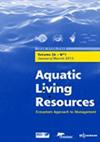Growth, mortality and yield of Sarotherodon melanotheron melanotheron (Rüppell, 1852) in the Lake Nokoué and Porto-Novo Lagoon complex Benin, West Africa
IF 1.5
4区 农林科学
Q3 FISHERIES
引用次数: 2
Abstract
The study evaluated some population parameters of Sarotherodon melanotheron melanotheron within a lagoon complex in southern Benin: Lake Nokoué and Porto-Novo Lagoon. Data on the total length, total weight, and sex were recorded monthly between January and December 2015 for 1,745 specimens captured by local fishermen. The asymptotic length L∞ was estimated at 24.68 cm. The growth rate K was 0.86. The total, natural, and fishing mortalities were estimated at 2.46, 1.71, and 0.75 y−1, respectively. The size at first sexual maturity was 8.9 and 9.2 cm, respectively, for males andfemales. The size at first capture was estimated at 9.2 cm, which indicates that fish spawn at least once before capture. The current exploitation rate of 0.31 remains below the maximum exploitation rate Emax which was 0.604 but was equal to the exploitation rate retaining 50% of the biomass of the stock (E0.5 = 0.324). This suggests that the stock of S. m. melanotheron is not overexploited in the complex. However, it is recommended that the actual rate of exploitation be kept as it is to ensure a sustainable management of these fish populations.西非贝宁nokou湖和Porto-Novo泻湖群中Sarotherodon melanotheron (r pell, 1852)的生长、死亡率和产量
本研究评估了贝宁南部nokou湖和波尔图-诺沃湖泻湖中Sarotherodon melanotheron的一些种群参数。在2015年1月至12月期间,每月记录当地渔民捕获的1,745个标本的总长度、总重量和性别数据。渐近长度L∞估计为24.68 cm。生长速率K为0.86。估计总死亡率、自然死亡率和捕捞死亡率分别为2.46、1.71和0.75 y - 1。雄性和雌性性成熟时的体长分别为8.9 cm和9.2 cm。第一次捕获时的大小估计为9.2厘米,这表明鱼在捕获前至少产卵一次。目前0.31的开采率仍低于最大开采率Emax(0.604),但等于保留50%生物量的开采率(E0.5 = 0.324)。这表明s.m.b ilotheron的种群在该复合体中没有被过度利用。但是,建议保持实际的捕捞率,以确保对这些鱼类种群的可持续管理。
本文章由计算机程序翻译,如有差异,请以英文原文为准。
求助全文
约1分钟内获得全文
求助全文
来源期刊

Aquatic Living Resources
农林科学-海洋与淡水生物学
CiteScore
2.30
自引率
0.00%
发文量
10
审稿时长
>24 weeks
期刊介绍:
Aquatic Living Resources publishes original research papers, review articles and propective notes dealing with all exploited (i.e. fished or farmed) living resources in marine, brackish and freshwater environments.
Priority is given to ecosystem-based approaches to the study of fishery and aquaculture social-ecological systems, including biological, ecological, economic and social dimensions.
Research on the development of interdisciplinary methods and tools which can usefully support the design, implementation and evaluation of alternative management strategies for fisheries and/or aquaculture systems at different scales is particularly welcome by the journal. This includes the exploration of scenarios and strategies for the conservation of aquatic biodiversity and research relating to the development of integrated assessment approaches aimed at ensuring sustainable and high quality uses of aquatic living resources.
 求助内容:
求助内容: 应助结果提醒方式:
应助结果提醒方式:


